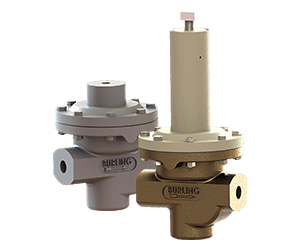 Mechanical pressure regulators like spring-loaded regulators or pilot-operated volume boosters play a key role in maintaining pressure in fluid systems. Unfortunately, the performance of these pressure regulators can be affected by inaccuracies. Understanding the mechanics of pressure regulators and how they operate can shed light on common inaccuracies and how to address them.
Mechanical pressure regulators like spring-loaded regulators or pilot-operated volume boosters play a key role in maintaining pressure in fluid systems. Unfortunately, the performance of these pressure regulators can be affected by inaccuracies. Understanding the mechanics of pressure regulators and how they operate can shed light on common inaccuracies and how to address them.
The Role of Pressure Regulators
The fundamental role of a pressure regulator is to mechanically maintain a consistent pressure in a fluid system, regardless of fluctuations in input pressure or process variations. This is accomplished by adjusting the flow of fluid through the pressure regulator’s valve mechanism in response to changes in pressure.
Pressure Regulator Operation
Pressure regulators typically consist of three primary components:
- Sensing Element – Monitors the system’s pressure
- Reference Element – Sets the required pressure level
- Control Element – Modulates the flow of fluid to maintain the required pressure
When the system pressure deviates from the set pressure, the sensing element detects the difference and sends a mechanical input to the control element. The control element then adjusts the valve operation to either add or exhaust media, thus bringing the pressure back to the required level. The sensing and reference element are often a common assembly such as a diaphragm or piston with the reference pressure (from a spring or air pilot) on one side and the sensed output pressure on the other. A force imbalance across the piston or diaphragm causes motion in the piston or diaphragm that is transmitted via mechanical linkage to the control element (valve) changing its position to either add or exhaust media from the process to maintain pressure.
How Mechanical Inaccuracies Affect Pressure Regulator Performance
Despite their precision engineering, pressure regulators are subject to mechanical inaccuracies that can affect their performance. Factors like droop, hysteresis, deadband, sensitivity variation and mounting variation can all play a role.
Droop
Droop is the decrease in outlet pressure as the flow rate increases. That is, even if the setpoint remains constant, the regulator’s output pressure tends to drop as the demand for fluid flow rises. This occurs due to inherent friction and mechanical limitations within the regulator’s valve mechanism.
Hysteresis
Hysteresis is the difference in output pressure when approaching the set pressure from either an initially higher, or lower pressure. This is due to friction and mechanical play in the linkages between sensing element and controlling element.
Deadband
Deadband is generally a purposeful introduction of a small pressure window around the setpoint where control action will not occur. It is typically introduced to prevent the regulator hunting around the setpoint or causing oscillation.
Sensitivity Variation
Sensitivity variation occurs when the regulator’s response to changes in input pressure varies across different operating conditions. This phenomenon can also occur in a system over time. Inconsistency in sensitivity can result from factors such as temperature fluctuations, wear and tear of components, or changes in fluid properties.
Mounting Variation
Mounting variation occurs when the orientation of the regulator affects the output pressure due to gravitational effects on the masses inside the regulator causing a bias in the output pressure. This is typically seen on low pressure applications. The mechanical forces generated by the media on the pressure regulating components are relatively smaller at the lower pressures compared to the forces introduced by gravity acting on the same components.
Addressing Mechanical Inaccuracies
Addressing mechanical inaccuracies allows engineers to further enhance the performance and reliability of pressure regulation systems, ensuring precise control and stability in a variety of processes. Two common things regulator manufacturers incorporate to address some of these inaccuracies include increasing the size of the Sensing/Reference element for more mechanical advantage for the existing pressure conditions, and the use of a pitot tube or similar function to help reduce droop as flow increases. These methods help the performance, however are not perfect as friction and mechanical play are still present.
The best way to overcome these mechanical limitations is to use closed loop electronic control. An electronic pilot with electronic pressure feedback is capable of overcoming the hysteresis and droop inherent with mechanical regulators. The pressure feedback allows the electronic regulator to apply the correct pilot pressure to achieve the correct output pressure regardless of operation condition changes such as supply pressure fluctuations and process fluctuations. The electronic control also has the added benefit of real time remote monitoring using an electric signal on a wire instead of plumbing a remote gauge.
Understanding the flow required for a particular application is critical to implementing the correct product in a process. An oversized regulator may have issues holding a tight setpoint and may have stability issues due to its ability to move a lot of media and change setpoint to rapidly causing overshoot/undershoot and possibly oscillation. An undersized regulator will not deliver sufficient media to the process.
The QB2, Volume Booster & Transducer
A Proportion-Air QB-2, volume booster, and transducer assembly produces a high flow electronically controlled pressure package. Adding the transducer downstream compensates for the mechanical inaccuracies and hysteresis of the volume booster, and accuracy of ±0.5% is achieved.
1. QB2X Electronic Pressure Regulator – provides an air pilot signal to the dome of the air volume booster. By controlling pressure to the top of the diaphragm, pressure out of the volume booster is controlled.
2. Air Volume Booster – also known as a dome-loaded or pilot-operated pressure regulator, this can be a pressure reducing valve or a back pressure valve. Many volume boosters are available that can handle different pressures, medias and flow rates.
3. DSB or DST Pressure Transducer – measures output pressure of the volume booster and provides feedback signal to the QB2. The QB2 adjusts dome pressure (based on this feedback) to achieve the commanded pressure in the process.
The downstream pressure transducer feeds an electronic control signal back to the electronic regulator (pilot) so that the control loop is closed around the actual output pressure. This overcomes any mechanical inaccuracies and hysteresis issues inherent in the mechanical regulator.


 High Accuracy Testing at High Pressures
High Accuracy Testing at High Pressures  What’s a Steam Regulator?
What’s a Steam Regulator?  Product of the Month | QPV1
Product of the Month | QPV1  Product of the Month | GX1
Product of the Month | GX1